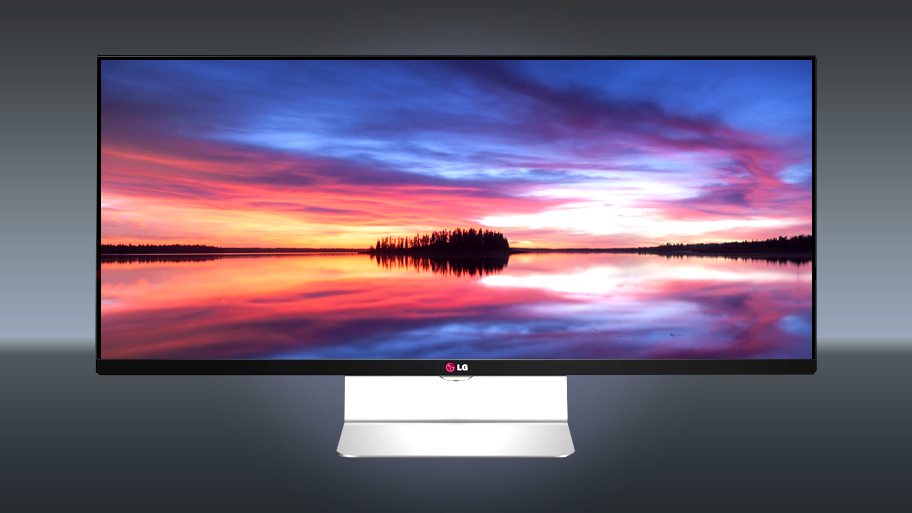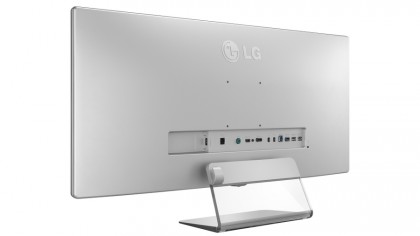LG on the world's first UQHD monitor, 'cinematic' 21:9 and curved displays
The 34UM95 is a blockbuster panel engineered for Hollywood

The term "unique" gets bandied about a lot when it comes to tech, but LG's attention-grabbing PC monitor, the 34-inch 34UM95, really deserves the name. There just isn't another one like it.
Instead of opting for the current poster child of next-gen display formats that is 4K, the South Korean company decided to make it the world's first 21:9 UltraWide QHD panel.
Displays featuring the "cinematic" 21:9 aspect ratio, including LG's EA93 from 2012, have so far proved monitor Marmite due to offering tons of horizontal space, but limiting vertical pixels to 1080p. The 34UM95 raises the stakes by upping the pixel resolution to 3,440 x 1,440, which makes it more of a wide boy than Tony Soprano while providing the same roomy vertical space as 27-inch+ QHD panels.
But it won't be plain sailing for LG's larger-than-life offering: the price of 4K monitors seems to be constantly on the decline, posing a question as to the 34UM95's longer term appeal. At £890 (about US$1,348, AU$1,612), it's not quite something you'll be picking up with spare change.
The question is: has LG latched onto a winner, or is there a reason as to why no other company has ventured into this intriguing purgatory between 4K heaven and 1080p hell? We spoke to Harold de Vries, the company's head of B2B Marketing, to find the answer.
Why UQHD?
TechRadar Pro: LG was the first (and is still the only) company to offer a 34-inch UQHD monitor. What was the thinking behind it?
Harold de Vries: We see that there is a growing interest in the Ultrawide 21:9 monitor range - especially from graphic designers, music editors and so on - who require quite a lot of apps to be open at the same time and require better visibility.
Are you a pro? Subscribe to our newsletter
Sign up to the TechRadar Pro newsletter to get all the top news, opinion, features and guidance your business needs to succeed!
One of the reasons we went for QHD instead of 4K is the price point. If you look at 4K at 34-inches, or at least 21:9 widescreen ratio, you're talking about a price point of about $2,000. With QHD you get into a price point well under £1,000, so there's a lot of demand in that segment.
You still get all the benefits of a 34-inch widescreen monitor while making a sort of compromise to the screen resolution. We've also implemented Thunderbolt 2, a world's first. With that we focus primarily on Apple users - people who are doing a lot of graphic design work - and we try to target that segment of the market.
TRP: So you're targeting people who want a large monitor and resolution but aren't prepared to shell out for 4K?
HDV: Yes. 4K is going to be the future, but at present there's the issue of cost. It's not only that - we're also targeting market share in what is a relatively new segment - which is important. QHD provides almost all the benefits of 4K, but that market hasn't been tapped into by our competitors, as they're all going for 4K. We have an empty playing field to compete on.
TRP: One criticism aimed at 21:9 monitors with 2,560 x 1,080 pixel-resolutions is that the width is great, but there isn't much vertical space. Was the decision to move to 3,440 x 1,440 pixels based on such feedback?
HdV: I joined LG after [the resolution] decision was made, so I can't comment on that. However, we saw after interviews with target customers - such as video and music editors, graphic designers, photographers and other people who need to do a lot of post-editing of their work - that while 29 inches is very big and convenient, having those five inches gives you that bit more visibility, and the potential to have four split screens. It's a progression and evolution, instead of revolution.

Putting 21:9 to work
TRP: In the B2B space 21:9 monitors monitors can be used for anything from finance to productivity. Can you talk about how any of your customers are using LG's displays?
HdV: Sky News and their digital news editing team have been testing our 29-inch 21:9 displays in a bid to increase productivity. Of course, news editing and gathering requires a lot of different sources - from Twitter, Facebook and other social media - these days.
They were using three or four monitors per desk, but with the 21:9 panels could cut them back to two, or maybe three (to dedicate one for showing a live news stream). Their internal customers, the news editors, were really keen on them and nearly took me hostage when I wanted to take them back. It's now just a case of them making their internal procurement decision to use them.
They have Sky News running at the same time as using news-editing apps. They used the dual-screen functionality (to show different inputs on each half of the display) primarily for editing the news, editing articles and having social media open at the same time. It allowed them to maintain visibility without switching between different screens of different resolutions and sizes, which can cause eye-strain as you have to keep adjusting.
Our displays are also being trialled at the Bank of England. The finance industry is one where people on the trade floor need a lot of apps and visibility, so widescreen is perfect for those guys.
Plane decision
TRP: You stuck with an IPS panel type running at 60Hz for the 34UM95. Why?
HdV: In-plane Switching (IPS) still has a lot of advantages - such as the wider viewing angles - allowing you to view the screen properly from about 178 degrees. It has a lot better colour calibration too, so a true red will be red on the screen - it won't turn into something like orange. It's the same with other colours.
IPS also has a much lower colour temperature on the screen, which helps with moving images of games, but also with inevitably some burning in of the screen after long-term usage. So there are a lot more advantages to IPS technology than just making it available for larger screen resolutions.
TRP: It's increasingly important for smartphones, tablets and other devices to be compatible with PC monitors and TVs. With that in mind, how do you decide what set of connectivity options go into a flagship monitor like the 34UM95?
HdV: It's very important that we get that right. We see a trend in the market that's going toward DisplayPort because of its advantages when it comes to data transmission. But our monitor is the first with an actual Thunderbolt 2 connection, and with that, again, we tap into a very big market which is Apple dominated.
There are some other manufactures that have connectivity with Apple products, but with Thunderbolt 2, the connectivity gets even better and quicker. That was one of the key components that we wanted to add to the 34UM95, especially as we're targeting people who use Apple products because of the advantages over Windows-based operating systems. Other connections such as HDMI are still important.
Target audience
TRP: What types of consumers do you think will be the first to dip their toes into the 34UM95?
HdV: It's very difficult to say. We target graphic designers, music and video editors, so it's still really the professionals and "prosumers". Then, the next generation would be the real hardcore gamers who want the best screen for their hobby. I wouldn't call them early adopters, but perhaps early followers.
TRP: Because of the size of the screen, if you're a home-based office worker and a PC gamer, you could ditch your normal 32-inch TV and PC monitor, instead using a 34UM95 to save space...
HdV: You could use it like that, especially if you're a film enthusiast as all the Hollywood films are shot in 21:9 ratio instead of 16:9. So you have the actual film as it was shot and as it was intended to be, so even there you have an advantage. Would you replace a small TV with it? I don't know - that's up to the end user. It's an option.
